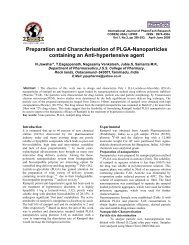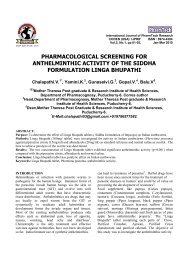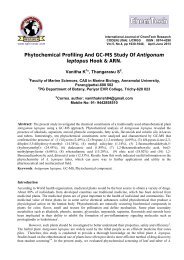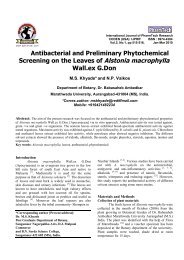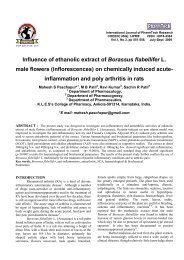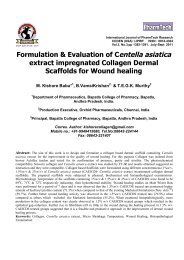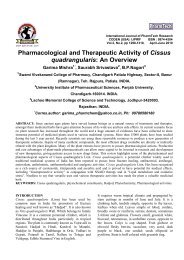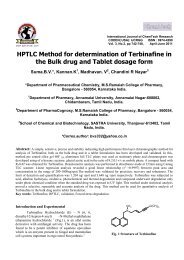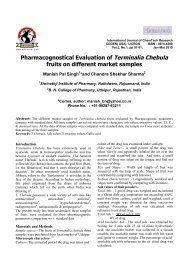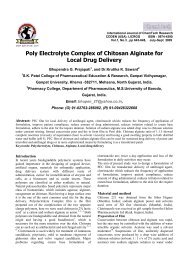Evaluation of In-Vitro Antioxidant and Antimicrobial Activities of the ...
Evaluation of In-Vitro Antioxidant and Antimicrobial Activities of the ...
Evaluation of In-Vitro Antioxidant and Antimicrobial Activities of the ...
You also want an ePaper? Increase the reach of your titles
YUMPU automatically turns print PDFs into web optimized ePapers that Google loves.
<strong>In</strong>ternational Journal <strong>of</strong> PharmTech Research<br />
CODEN (USA): IJPRIF ISSN : 0974-4304<br />
Vol.4, No.4, pp 1367-1376, Oct-Dec 2012<br />
<strong>Evaluation</strong> <strong>of</strong> <strong>In</strong>-<strong>Vitro</strong> <strong>Antioxidant</strong> <strong>and</strong><br />
<strong>Antimicrobial</strong> <strong>Activities</strong> <strong>of</strong> <strong>the</strong> Various Parts <strong>of</strong><br />
Benincasa hispida<br />
Noriham Abdullah, *Wan Saidatul Syida Wan Kamarudin,<br />
Zainal Samicho, Nurain Aziman <strong>and</strong> Khairusy Syakirah Zulkifli<br />
Faculty <strong>of</strong> Applied Sciences, Universiti Teknologi MARA, 40450 Selangor, Malaysia<br />
Corresponding Author: Wan Saidatul S.W.K, Faculty <strong>of</strong> Applied Sciences, Universiti<br />
Teknolog MARA, 40450 Selangor, Malaysia: +60132677647.<br />
*Corres.author: <strong>the</strong>rmopolis_mia@yahoo.com<br />
Abstract: Benincasa hispida (wax gourd), a fruit that consumed by many Asians, belongs to <strong>the</strong> family<br />
curcubitaceae. The present study was under taken to investigate <strong>the</strong> antioxidant <strong>and</strong> antimicrobial activities<br />
<strong>of</strong> <strong>the</strong> pulp, peel <strong>and</strong> seed extracts <strong>of</strong> wax gourd. The various parts <strong>of</strong> wax gourd were extracted with water.<br />
<strong>Antioxidant</strong> estimation <strong>of</strong> <strong>the</strong> extracts were analysed for <strong>the</strong> total phenolic content (TPC) measured using<br />
Folin-Ciocalteu reagent assay. The antioxidant activity (AO) <strong>of</strong> various parts <strong>of</strong> wax gourd were evaluated<br />
using ferric reducing antioxidant potential (FRAP), 2,2-diphenyl-1-picryl hydrazyl (DPPH) <strong>and</strong> β-carotene<br />
bleaching assays. The antimicrobial activity <strong>of</strong> <strong>the</strong> extracts was tested against six Gram-positive <strong>and</strong> seven<br />
Gram-negative bacteria, one yeast <strong>and</strong> two mold using <strong>the</strong> disc diffusion method. The seed extract <strong>of</strong> wax<br />
gourd showed <strong>the</strong> highest TPC (207.9 mg Gallic acid equivalent (GAE)/g extract weight) while AO <strong>of</strong> peel,<br />
pulp <strong>and</strong> seed <strong>of</strong> wax gourd were 21.73, 26.71 <strong>and</strong> 35.06 mM Trolox equivalent (TE)/g extract weight,<br />
respectively as determined by FRAP assay. As for EC50 values <strong>of</strong> DPPH assay were 165.42 (seed), 195.17<br />
(pulp) <strong>and</strong> 392.21 μg/ml (peel). AO based on β-carotene bleaching assay were 34.39% (peel), 76.27% (pulp)<br />
<strong>and</strong> 90.22% (seed). The various parts <strong>of</strong> wax gourd extracts as determined by all AO assays were correlated<br />
with TPC <strong>and</strong> <strong>the</strong> value varies from -0.999 ≤ r 2 ≤ 0.874. The antimicrobial activity <strong>of</strong> <strong>the</strong> extracts showed an<br />
inhibition towards Gram-negative bacteria ( Salmonella typhimurium, Pseudomonas aeruginosa, Proteus<br />
vulgaris, Serratia liquefaciens, Cronobacter muytjensii, Shigella boydii <strong>and</strong> Serratia marcescens) compared<br />
to Gram-positive bacteria, however, <strong>the</strong>re are no inhibition towards yeast <strong>and</strong> mold for all extracts. Results<br />
may suggested that seed extract <strong>of</strong> wax gourd possesed strong antioxidant <strong>and</strong> antibacterial activities. Hence,<br />
<strong>the</strong>y had <strong>the</strong> potential as natural preservatives in food, cosmetic <strong>and</strong> pharmaceutical industries for<br />
applications.<br />
Keywords: Benincasa hispida, Total phenolic content, <strong>Antioxidant</strong> activity, <strong>Antimicrobial</strong> .<br />
<strong>In</strong>troduction<br />
Natural antioxidant mainly from fruits <strong>and</strong><br />
vegetables have gained interest among consumers<br />
<strong>and</strong> scientists because various epidemiological 1,2<br />
<strong>and</strong> laboratory studies shown that frequent<br />
consumption <strong>of</strong> natural antioxidant may reduce <strong>the</strong><br />
cardiovascular disease 3 <strong>and</strong> cancer 4,5 . Three major<br />
groups that are related to defensive effects <strong>of</strong><br />
natural antioxidant <strong>and</strong> antimicrobial in fruits <strong>and</strong>
Wan Saidatul Syida Wan Kamarudin et al /<strong>In</strong>t.J.PharmTech Res.2012,4(4) 1368<br />
vegetables are vitamins, polyphenols <strong>and</strong><br />
carotenoids 5 . Plant secondary metabolites such as<br />
polyphenols, have properties including antioxidant,<br />
antimugenic, anticarcinogenic, antiflammatory <strong>and</strong><br />
antimicrobial effects that might preventing<br />
diseases 5 .<br />
Benincasa hispida (Thunb) is one <strong>of</strong> <strong>the</strong> species <strong>of</strong><br />
cucurbitaceae family that are grown primarily for<br />
its fruits <strong>and</strong> also has a great potential for<br />
functional food production 6 . <strong>In</strong> Malaysia, only two<br />
cultivar (round shape <strong>and</strong> elongated) <strong>of</strong> wax gourd<br />
are grown for commercial purposes. The peel <strong>and</strong><br />
seed residue is <strong>the</strong> primary waste fraction. Several<br />
studies have already realized that <strong>the</strong> pulp <strong>and</strong> seed<br />
<strong>of</strong> <strong>the</strong> wax gourd has many beneficial effects for<br />
example <strong>the</strong> peel has antioxidant activity <strong>and</strong><br />
capable for inhibition <strong>of</strong> angiotensin converting<br />
enzyme (ACE) 7 while <strong>the</strong> seed has angiogenic<br />
effect, anti tumor, used for <strong>the</strong> treatment <strong>of</strong><br />
syphilis, cardiovascular diseases <strong>and</strong><br />
antioxidant 8,9,10,11 . However, <strong>the</strong> antimicrobial<br />
activities <strong>of</strong> peel, pulp <strong>and</strong> seed <strong>of</strong> wax gourd have<br />
not been investigated.<br />
<strong>Antioxidant</strong>s are <strong>the</strong> compounds that can delay or<br />
inhibit <strong>the</strong> oxidation <strong>of</strong> lipids or o<strong>the</strong>r molecules by<br />
inhibiting <strong>the</strong> initiation or propagation <strong>of</strong> oxidizing<br />
chain reaction 12 , while antimicrobial are compound<br />
or substance that kills or slows down <strong>the</strong> growth <strong>of</strong><br />
bacteria <strong>and</strong> fungus (mold <strong>and</strong> yeast). The ability<br />
polyphenolic compounds to act as scavengers <strong>of</strong><br />
free radicals besides <strong>the</strong>ir antioxidant <strong>and</strong><br />
antimicrobial properties raising <strong>the</strong> possibility <strong>of</strong><br />
<strong>the</strong>ir function in food <strong>and</strong> pharmaceutical<br />
application.<br />
The aim <strong>of</strong> this research were to compare <strong>the</strong><br />
antioxidant activity (AOA) using different types <strong>of</strong><br />
assays namely DPPH, FRAP <strong>and</strong> β- carotene<br />
bleaching <strong>and</strong> to investigate <strong>the</strong> antimicrobial<br />
activity <strong>of</strong> peel, pulp <strong>and</strong> seed <strong>of</strong> wax gourd<br />
extracts by using disc diffusion method.<br />
Experimental<br />
Plant materials<br />
Wax gourd fruits were harvested at matured stage<br />
<strong>and</strong> were purchased from a local market in<br />
Selayang, Selangor, Malaysia.<br />
Extractions<br />
Fruit extracts for ascorbic acid analysis were<br />
obtained by homogenizing 1 g <strong>of</strong> wax gourd tissue<br />
(peel, pulp <strong>and</strong> seed) in 5 ml 80% acetone until<br />
uniform consistency. The homogenates were<br />
centrifuged at 2,500 rpm at 4 °C for 20 minutes.<br />
The peel,pulp <strong>and</strong> seed <strong>of</strong> wax gourd extracts for<br />
total phenolic <strong>and</strong> antioxidant activity were<br />
prepared according to <strong>the</strong> method <strong>of</strong> Duh <strong>and</strong> Yen<br />
(1997) 13 . Each part <strong>of</strong> wax gourd was extracted<br />
with distilled water for 20 minutes <strong>and</strong> <strong>the</strong> ratio<br />
between samples to extraction medium was 1:5.<br />
The mixture was <strong>the</strong>n filtered through a filter paper<br />
(Whatman No. 4) using a buchner funnel. After<br />
filtration, <strong>the</strong> filtrate was evaporated by using<br />
rotary evaporator (R-20, Buchi, Switzerl<strong>and</strong>). The<br />
extracts were later dried completely using a<br />
lyophilizer (ALPHA 1-4 LO plus, CHRIST freeze<br />
dried).<br />
<strong>Antioxidant</strong> estimations<br />
Total phenolic content (TPC)<br />
Total phenolic content was determined by Folin-<br />
Ciocalteau method, which was adapted from<br />
Singleton <strong>and</strong> Rossi (1965) 14 . 0.1 ml <strong>of</strong> an aliquot<br />
<strong>of</strong> <strong>the</strong> extract was added to 0.5 ml Folin-Ciocalteau<br />
reagent in a test tube <strong>and</strong> <strong>the</strong>n mixed well using a<br />
vortex. The mixture was allowed to react for 3<br />
minutes <strong>the</strong>n 1.5 ml <strong>of</strong> 7.5 % w/v Na2CO3 <strong>and</strong> 7.9<br />
ml distilled water was added <strong>and</strong> mixed well. The<br />
solution was incubated at room temperature (23°C)<br />
in <strong>the</strong> dark for 2 hour.After 2 hours incubation at<br />
room temperature,<strong>the</strong> absorbance was read at 765<br />
nm using a spectrophotometer. The amount <strong>of</strong> <strong>the</strong><br />
total phenolic content was expressed in mg <strong>of</strong><br />
gallic acid equivalent using <strong>the</strong> st<strong>and</strong>ard curve.<br />
<strong>Antioxidant</strong> activity determinations<br />
Scavenging activity on 2,2-diphenyl-2-picryl<br />
hydrazyl radical (DPPH assay)<br />
The DPPH free radical scavenging activity <strong>of</strong> each<br />
sample was conducted according to <strong>the</strong> method<br />
described by (Braca et al., 2001) 15 . A solution <strong>of</strong><br />
0.1 mM DPPH in ethanol was prepared. The<br />
butylated hydroxytoluene (BHT) / butylated<br />
hydroxyannisole (BHA) combination <strong>and</strong> ascorbic<br />
acid were used as st<strong>and</strong>ards. The concentration <strong>of</strong><br />
extracts <strong>and</strong> st<strong>and</strong>ards were prepared from 200<br />
until 1000 μg/ml. An aliquot <strong>of</strong> 0.6 ml <strong>of</strong> each<br />
concentration <strong>of</strong> extracts <strong>and</strong> st<strong>and</strong>ards were added<br />
to 4.5 ml <strong>of</strong> ethanolic DPPH solution. The mixture<br />
was shaken vigorously <strong>and</strong> left to st<strong>and</strong> for 20<br />
minutes at room temperature in a dark room.<br />
Absorbance was read using a spectrophotometer at<br />
517 nm. EC50 value was determined from <strong>the</strong><br />
plotted graph <strong>of</strong> scavenging activity against <strong>the</strong><br />
concentration <strong>of</strong> extracts which is defined as <strong>the</strong><br />
total antioxidant necessary to decrease <strong>the</strong> initial<br />
DPPH radical concentration by 50 % 16 .
Wan Saidatul Syida Wan Kamarudin et al /<strong>In</strong>t.J.PharmTech Res.2012,4(4) 1369<br />
Ferric reducing activity power (FRAP assay)<br />
The FRAP assay was done according to Benzie<br />
<strong>and</strong> Strain (1996) 17 . The stock solutions included<br />
300mM acetate buffer (3.1 g C2H3NaO2, 3H2O <strong>and</strong><br />
16ml C2H4O2), pH 3.6, 10mM TPTZ (2, 4, 6 -<br />
tripyridyl-s-triazine) solution in 40mM HCl, <strong>and</strong><br />
20mM FeCl3.6H2O solution. The fresh working<br />
solution was prepared by mixing 25 ml acetate<br />
buffer, 2.5 ml TPTZ solution, <strong>and</strong> 2.5 ml<br />
FeCl3.6H2O solution <strong>and</strong> <strong>the</strong>n warmed at 37°C<br />
before using. The extracts (150 ml) were allowed<br />
to react with 2850 μl <strong>of</strong> <strong>the</strong> FRAP solution for 1<br />
hour in <strong>the</strong> dark condition. Readings <strong>of</strong> <strong>the</strong> colored<br />
product [ferrous tripyridyltriazine complex] were<br />
<strong>the</strong>n taken at 593 nm. The st<strong>and</strong>ard curve was<br />
linear between 100 <strong>and</strong> 500 mM Trolox. Results<br />
are expressed in mM TE/g extract weight.<br />
β-carotene bleaching assay<br />
The β-carotene bleaching assay was determined by<br />
<strong>the</strong> spectrophotometric method at 470 nm adapted<br />
by Velioglu et al. (1998) 12 . This assay was carried<br />
out to measure <strong>the</strong> % antioxidant activity <strong>of</strong><br />
extracts <strong>of</strong> each part. <strong>In</strong> this method combination<br />
<strong>of</strong> BHA/BHT at 200 μg/ml was used as <strong>the</strong><br />
st<strong>and</strong>ard. 0.2 mg/ml <strong>of</strong> β-carotene was dissolved in<br />
chlor<strong>of</strong>orm, 0.02 ml linoleic acid <strong>and</strong> 0.2 ml<br />
Tween 20 were transferred into a 50 ml round<br />
bottom flask. Chlor<strong>of</strong>orm was <strong>the</strong>n removed at<br />
room temperature under vacuum at reduced<br />
pressure using a rotary evaporator (R -20, Buchi,<br />
Switzerl<strong>and</strong>) for 10 minutes. After evaporation, 50<br />
ml <strong>of</strong> distilled water was added to<br />
<strong>the</strong> mixture <strong>and</strong> shaken vigorously to form an<br />
emulsion. 2 ml aliquots <strong>of</strong> <strong>the</strong> emulsion was<br />
pipetted into 0.2 ml <strong>of</strong> extract, st<strong>and</strong>ard <strong>and</strong> water<br />
(as control) <strong>and</strong> immediately placed in a water bath<br />
(Memmert, Kuala Lumpur, Malaysia) at 50°C.The<br />
absorbance was read at 20 minutes intervals for 2<br />
hours at 470 nm <strong>and</strong> <strong>the</strong> rate <strong>of</strong> bleaching <strong>of</strong> βcarotene<br />
was recorded to calculate <strong>the</strong> %<br />
antioxidant activity <strong>of</strong> each part <strong>of</strong> wax gourd<br />
extracts.<br />
<strong>Evaluation</strong> <strong>of</strong> <strong>Antimicrobial</strong> Activity<br />
Bacterial strains<br />
The antibacterial activity <strong>of</strong> fruit peels extracts was<br />
evaluated using seven Gram-positive bacteria <strong>and</strong><br />
seven Gram-negative bacteria. All <strong>the</strong> bacterial<br />
strains were obtained from Laboratory <strong>of</strong><br />
Microbiology, Faculty <strong>of</strong> Applied Sciences,<br />
Universiti Teknologi MARA, Shah Alam,<br />
Malaysia. The microorganism strains were<br />
inoculated in universal bottle containing nutrient<br />
broth at 37°C for 24 h in Tryptic Soy Broth (TSB)<br />
(Merck, Germany). The optical density (O.D) <strong>of</strong><br />
<strong>the</strong> bacterial suspension was adjusted<br />
turbidometrically to 1.1 O.D at wavelength <strong>of</strong><br />
600nm.<br />
Mold <strong>and</strong> Yeast strains<br />
Mold <strong>and</strong> Yeast strains were obtained from<br />
Laboratory <strong>of</strong> Microbiology, Faculty <strong>of</strong> Applied<br />
Sciences, Universiti Teknologi MARA, Shah<br />
Alam, Malaysia. The microorganism strains were<br />
inoculated in universal bottle containing potato<br />
dextrose broth at 30°C for 72 h in Tryptic Soy<br />
Broth (TSB) (Merck, Germany). The optical<br />
density (O.D) <strong>of</strong> <strong>the</strong> bacterial suspension was<br />
adjusted turbidometrically to 1.1 O.D at<br />
wavelength <strong>of</strong> 540nm.<br />
Disc Diffusion Method<br />
The screening <strong>of</strong> <strong>the</strong> extracts on antibacterial<br />
activity was carried out by determining <strong>the</strong><br />
diameter zone <strong>of</strong> inhibition using paper disc (6 mm<br />
in diameter, Whatman No. 1) diffusion method.<br />
The sterile discs impregnated with 25 µl <strong>of</strong> extract<br />
solution with varied concentration (25 to<br />
100mg/ml extract) were placed in inoculated agar<br />
that has been swabbed with adjusted bacteria. The<br />
zones <strong>of</strong> growth inhibition around <strong>the</strong> discs were<br />
measured after 18 to 24 h <strong>of</strong> incubation at 37 °C.<br />
Chloramphenicol (10 μg/disc), Vancomycin (5<br />
μg/disc), Penicillin G (1 unit), Streptomycin (10<br />
μg/disc), Gentamicin (35 μg/disc) <strong>and</strong> distilled<br />
water were used as st<strong>and</strong>ard for bacteria <strong>and</strong><br />
Nystatin ( 10 μg/disc) was used as st<strong>and</strong>ard for<br />
mold <strong>and</strong> yeast. The controls were prepared using<br />
<strong>the</strong> same solvents without extracts. The sensitivity<br />
<strong>of</strong> <strong>the</strong> microorganism species to <strong>the</strong> crude extracts<br />
was determined by measuring <strong>the</strong> sizes <strong>of</strong><br />
inhibitory zones (including <strong>the</strong> diameter <strong>of</strong> disc) on<br />
<strong>the</strong> agar surface around <strong>the</strong> disks, <strong>and</strong> values
Wan Saidatul Syida Wan Kamarudin et al /<strong>In</strong>t.J.PharmTech Res.2012,4(4) 1370<br />
Ciocalteu method is based on oxidation/reduction<br />
on redox properties <strong>of</strong> antioxidant compound<br />
presence in <strong>the</strong> extract that can react with Folin-<br />
Ciocalteu <strong>and</strong> sodium carbonate produce blue color<br />
<strong>of</strong> phosphomolybdic-phosphotungstic phenol<br />
complex 14 . Thus, most concentrated blue color<br />
contains highest total phenolic content.<br />
Total Phenolic Content (TPC) were significantly<br />
different among each parts <strong>of</strong> wax gourd tested<br />
(Table 1). The TPC showed higher content in seed<br />
(207.9 mg GAE/g extract weight) followed by pulp<br />
(184.9 mg GAE/g extract weight) <strong>and</strong> peel (74.83<br />
mg GAE/g extract weight). This finding is not in<br />
agreement with Huang et al. (2005) 7 , who reported<br />
that <strong>the</strong>re was no significant difference in total<br />
phenolic content <strong>of</strong> various parts <strong>of</strong> wax gourd<br />
extracts. This may be due to different cultivated<br />
area, different species <strong>and</strong> different extraction<br />
methods used in <strong>the</strong> study. The high in total<br />
phenolic content in seed extract might be due to<br />
<strong>the</strong> presence <strong>of</strong> saponin 18 , amino acid 19 <strong>and</strong><br />
triterpenoids 20 . A study done by Baydar et al.<br />
(2006) 21 found that most plant by-products (fruit<br />
wastes) contain polyphenols with potential<br />
application as food antioxidant <strong>and</strong> Soong <strong>and</strong><br />
Barlow (2004) 22 demonstrated that fruit seeds had<br />
higher phenolic content than edible portions.<br />
Table 1:Total phenolic contents <strong>of</strong> various wax<br />
gourd parts<br />
(result expressed as mg GAE/g extract weight).<br />
Wax gourd parts TPC mg GAE/g extract<br />
weight<br />
Skin 74. 83 ± 1.42 C<br />
Pulp 184.9 ± 5.02 B<br />
Seed 207.9 ± 11.21 A<br />
Values are expressed as mean ± st<strong>and</strong>ard deviation<br />
(n = 3).<br />
Means with different letters were significantly<br />
different at <strong>the</strong> level p < 0.05.<br />
<strong>Antioxidant</strong> activity<br />
Scavenging activity on 2,2-diphenyl-2picrylhdrazyl<br />
radical (DPPH assay)<br />
<strong>In</strong> order to provide antioxidant potential <strong>of</strong> <strong>the</strong><br />
ability <strong>of</strong> each <strong>of</strong> wax gourd extracts to act as free<br />
radical scavengers or hydrogen donors, DPPH<br />
radical scavenging activity assay was carried out 23 .<br />
DPPH is a stable, nitrogen centered free radical<br />
which produces violet color in ethanol solution 24 .<br />
When <strong>the</strong> free radical have been scavenged, DPPH<br />
will generated its color to yellow because as odd<br />
electron <strong>of</strong> <strong>the</strong> radical becomes paired <strong>of</strong>f in <strong>the</strong><br />
presence <strong>of</strong> a hydrogen donor, <strong>the</strong> absorption<br />
intensity will be decreased <strong>and</strong> resulting<br />
discoloration with respect to <strong>the</strong> number <strong>of</strong><br />
electron captured 25,26 . The reduction in <strong>the</strong> number<br />
<strong>of</strong> DPPH molecules can be correlated with <strong>the</strong><br />
number <strong>of</strong> available hydroxyl groups 27 .<br />
Figure 1 showed that <strong>the</strong> scavenging activity <strong>of</strong> all<br />
extracts (peel, pulp <strong>and</strong> seed) on DPPH radicals<br />
increased rapidly from concentration <strong>of</strong> 200 μg/ml<br />
until it became plateau after concentration <strong>of</strong> 600<br />
μg/ml. EC50 value (<strong>the</strong> amount <strong>of</strong> antioxidant (AO)<br />
necessary to decrease <strong>the</strong> initial DPPH radical<br />
concentration by 50 percent (%) was determined<br />
from <strong>the</strong> plotted scavenging activity against <strong>the</strong><br />
concentration <strong>of</strong> various parts <strong>of</strong> wax gourd<br />
extracts graph.
Wan Saidatul Syida Wan Kamarudin et al /<strong>In</strong>t.J.PharmTech Res.2012,4(4) 1371<br />
Figure 1. Scavenging effect <strong>of</strong> various parts <strong>of</strong> wax gourd extract on DPPH radicals. Values are<br />
expressed as mean ± st<strong>and</strong>ard deviation (n = 3). A scorbic acid <strong>and</strong> BHAT/BHT were used as a<br />
st<strong>and</strong>ard.<br />
Table 2: <strong>Antioxidant</strong> activity <strong>of</strong> various parts <strong>of</strong> wax gourd extracts as determined by <strong>the</strong> DPPH<br />
(EC50), FRAP <strong>and</strong> β-carotene bleaching (% AA) assays.<br />
Part <strong>of</strong> Wax Gourd<br />
<strong>Antioxidant</strong> <strong>Activities</strong><br />
extract DPPH (EC50) a<br />
FRAP b<br />
Β-Carotene<br />
bleaching assay c<br />
BHA/BHT<br />
(St<strong>and</strong>ard)<br />
120.03 ± 0.18 C<br />
Not applicable 94.91 ± 4.5 A<br />
Ascorbic Acid<br />
(St<strong>and</strong>ard)<br />
104.03 ± 0.18 C<br />
Not applicable Not applicable<br />
Peel 392.21 ± 20.16 A<br />
21.73 ± 2.13 B<br />
34.39 ± 4.92 C<br />
Pulp 195.17 ± 20.04 B<br />
26.71 ± 3.05 B<br />
76.27 ± 13.41 B<br />
Seed 165.42 ± 0.25 B<br />
35.06 ± 5.68 A<br />
90.22 ± 7.68 A<br />
Values are expressed as mean ± st<strong>and</strong>ard deviation (n=3). Means with dif ferent letters were significantly<br />
different at <strong>the</strong> level p
Wan Saidatul Syida Wan Kamarudin et al /<strong>In</strong>t.J.PharmTech Res.2012,4(4) 1372<br />
Ferric reducing activity based on FRAP assay<br />
The seed extract <strong>of</strong> wax gourd exhibited <strong>the</strong><br />
highest antioxidant potential among <strong>the</strong> extracts<br />
(Table 2) based on <strong>the</strong> FRAP assay. However,<br />
<strong>the</strong>re was no significant difference between pulp<br />
<strong>and</strong> skin extract on <strong>the</strong> antioxidant potential in<br />
FRAP assay.<br />
<strong>In</strong> FRAP assay, reducing potential <strong>of</strong> an<br />
antioxidant reacting with ferric tripyridyltriazine<br />
(Fe3+-TPTZ) complex was measured <strong>and</strong><br />
producing a colored ferrous tripyridyltriazine<br />
(Fe2+-TPTZ) 17,30 . The reducing properties are<br />
associated with <strong>the</strong> presence <strong>of</strong> compounds in <strong>the</strong><br />
extracts breaking <strong>the</strong> free radical chain through<br />
donating a hydrogen atom 13 . The highest<br />
antioxidant potential <strong>of</strong> seed extract could be due<br />
to high in total phenolic content. <strong>In</strong> addition, <strong>the</strong>re<br />
was positive correlation between FRAP assay <strong>and</strong><br />
phenolic content (R 2 =0.874) for each part <strong>of</strong> <strong>the</strong><br />
wax gourd extracts. This result was in agreement<br />
with Benzie <strong>and</strong> Stezo (1999) 31 who found a strong<br />
correlation between total phenolic content <strong>and</strong><br />
FRAP assay. A study done by Gardner et al.<br />
(2000) 31 for apple <strong>and</strong> pineapple juices had also<br />
shown that <strong>the</strong> syn<strong>the</strong>tic free radical potassium<br />
nitrosodisulfonate (by using electron spin<br />
resonance) <strong>and</strong> Fe 3+ (by using FRAP) showe d<br />
strong correlation with phenolic content. Thus, in<br />
this study phenolic compound <strong>of</strong> seed extract <strong>of</strong><br />
wax gourd exhibited high reducing power on Fe 3+ -<br />
TPTZ. <strong>In</strong> addition, Rice et al. (1996) 32 reported<br />
that phenolic compounds have redox properties<br />
which allow <strong>the</strong>m to act as reducing agents,<br />
hydrogen donators <strong>and</strong> singlet oxygen quenchers.<br />
The redox potential <strong>of</strong> phenolic compound plays<br />
an important role in determining <strong>the</strong> antioxidant<br />
capacity 32 .<br />
β-Carotene-linoleate bleaching assay<br />
<strong>In</strong> this study, <strong>the</strong> percent antioxidant activity <strong>of</strong> <strong>the</strong><br />
various part <strong>of</strong> wax gourd extract were measured<br />
by <strong>the</strong> bleaching <strong>of</strong> β-carotene. Table 2 shows <strong>the</strong><br />
comparative β-carotene bleaching in percent<br />
antioxidant activity <strong>of</strong> <strong>the</strong> control, st<strong>and</strong>ard <strong>and</strong><br />
sample extracts. The st<strong>and</strong>ard (combination <strong>of</strong><br />
BHA/BHT) <strong>and</strong> seed extract <strong>of</strong> wax gourd did not<br />
show any significant <strong>and</strong> this indicates that <strong>the</strong><br />
st<strong>and</strong>ard <strong>and</strong> <strong>the</strong> seed extracts were able to inhibit<br />
<strong>the</strong> discoloration <strong>of</strong> β-carotene, however <strong>the</strong> skin<br />
extract <strong>and</strong> <strong>the</strong> pulp extract <strong>of</strong> wax gourd showed a<br />
significant difference (pseed>pulp>peel.<br />
Based on <strong>the</strong> percentage <strong>of</strong> antioxidant activity<br />
resulted from β-carotene bleaching assay, this<br />
study showed high correlation (0.989) between <strong>the</strong><br />
percent antioxidant activity <strong>and</strong> total phenolic<br />
content for all <strong>of</strong> <strong>the</strong> extracts. Our findings is in<br />
agreement with Yen et al. (2004) 33 <strong>and</strong> Norshazila<br />
et al. (2010) 29 , who reported that extracts with high<br />
amounts <strong>of</strong> total phenolic content also showed a<br />
high antioxidant activity.<br />
<strong>Antimicrobial</strong> activity<br />
<strong>In</strong> antimicrobial studies, <strong>the</strong> results (Table 4 <strong>and</strong><br />
Table 5) indicated that peel, pulp <strong>and</strong> seed <strong>of</strong> wax<br />
gourd extracts had showed more inhibitory effects<br />
against gram negatives bacteria compared to gram<br />
positive bacteria <strong>and</strong> seed extract showed <strong>the</strong> most<br />
inhibition zone especially on Cronobacter<br />
muytjensi, Shigella boydii <strong>and</strong> Serratia<br />
marcescens. However, <strong>the</strong>re are no inhibition for<br />
mold <strong>and</strong> yeast for all <strong>the</strong> wax gourd extracts. The<br />
st<strong>and</strong>ard antibacterial discs i.e., Chloramphenicol<br />
(10μg), Penicillin G (1 unit), Streptomycin (10μg),<br />
Vancomycin (5μg) <strong>and</strong> Gentamicin (30μg) showed<br />
a high inhibitory effects towards both Grampositive<br />
<strong>and</strong> Gram -negative bacterias as showed in<br />
Table 3 <strong>and</strong> <strong>the</strong> st<strong>and</strong>ard for mold <strong>and</strong> yeast also<br />
showed high inhibitory effects towards Aspergillus<br />
niger, Penicillium chrysogenum <strong>and</strong> C<strong>and</strong>ida<br />
albicans.<br />
<strong>In</strong> <strong>the</strong> present study, seed extracts <strong>of</strong> wax gourd<br />
was found higher in both Gram-positive <strong>and</strong> Gramnegative<br />
bacteria as compared to <strong>the</strong> peel <strong>and</strong> pulp<br />
extracts. This may be due to <strong>the</strong> presence <strong>of</strong><br />
miscellaneous compound such as steroid,<br />
alkaloids, triterpenoids <strong>and</strong> saponin 19 in <strong>the</strong> seed<br />
that has specificability to form pores in membranes<br />
cell <strong>of</strong> bacteria that are able to slow down <strong>the</strong><br />
growth <strong>of</strong> bacteria 34 . <strong>In</strong> addition, based on total<br />
phenolic content (TPC) results, seed possessed<br />
higher phenolic content <strong>and</strong> in previous study by<br />
Uchikoba et al. (1998) 19 showed that gallic acid<br />
was found to possess clear inhibitory effects<br />
against several panthogenic intestinal bacteria.
Wan Saidatul Syida Wan Kamarudin et al /<strong>In</strong>t.J.PharmTech Res.2012,4(4) 1373<br />
Table 3: Zones <strong>of</strong> inhibition produces by St<strong>and</strong>ard discs.<br />
Bacteria St<strong>and</strong>ards (<strong>In</strong>hibition zone ,mm)<br />
Chloramphenicol Penicillin G Streptomycin Vancomycin Gentamicin Distilled<br />
water<br />
10µg 1 unit 10µg 5µg 30µg -<br />
Gram-positive:<br />
Bacillus subtilis 20 ± 0.05 19 ± 0.04 23 ± 0.25 15 ± 0.12 26 ± 0.06 (-)<br />
Staphylococcus aureus 16 ± 0.04 9 ± 0.05 13 ± 0.06 9 ± 0.23 20 ± 0.08 (-)<br />
Micrococcus species 35 ± 0.04 27 ± 0.08 (-) 18 ± 0.04 23 ± 0.09 (-)<br />
Staphylococcus epidermidis 20 ± 0.06 21 ± 0.1 12 ± 0.09 12 ± 0.07 33 ± 0.23 (-)<br />
Staphylococcus xylosus 15 ± 0.07 21 ± 0.23 20 ± 0.34 12 ± 0.13 31 ± 0.43 (-)<br />
Bacillus circulans<br />
Gram-negative:<br />
23 ± 0.08 (-) 10 ± 0.07 (-) 15 ± 0.54 (-)<br />
Salmonella<br />
18 ± 0.01 (-) (-) (-)<br />
(-)<br />
typhimurium<br />
16 ± 0.05<br />
Pseudomonas aeruginosa 7 ± 0.04 7 ± 0.04 7 ± 0.12 (-) 12 ± 0.04 (-)<br />
Proteus vulgaris 10 ± 0.03 (-) 16 ± 0.86 12± 0.34 23 ± 0.03 (-)<br />
Serratia liquefaciens 16 ± 0.05 (-) 24 ± 0.45 (-) 22 ± 0.06 (-)<br />
Cronobacter muytjensii 26 ± 0.05 25 ± 0.23 23 ± 0.09 (-) 30 ± 0.45 (-)<br />
Shigella boydii 15 ± 0.06 (-) 14 ± 0.32 17 ± 0.05 (-) (-)<br />
Serratia marcescens 19 ± 0.07 (-) 11 ± 0.05 (-) 13 ± 0.08 (-)<br />
Values are expressed as mean ± st<strong>and</strong>ard deviation (n = 3).
Wan Saidatul Syida Wan Kamarudin et al /<strong>In</strong>t.J.PharmTech Res.2012,4(4) 1374<br />
Table 4: Zones <strong>of</strong> inhibition produces by peel, pulp <strong>and</strong> seed <strong>of</strong> wax gourd extracts.<br />
Bacteria<br />
Peel<br />
Aqueous extracts samples (<strong>In</strong>hibition zone ,mm)<br />
Pulp Seed<br />
0.63 1.25 2.5 0.63 1.25 2.5 0.63 1.25 2.5<br />
mg/ disc mg/ disc mg/ disc mg/ disc mg/ disc mg/ disc mg/ disc mg/ disc mg/ disc<br />
Gram-positive:<br />
Bacillus subtilis (-) (-) (-) (-) (-) (-) (-) (-) (-)<br />
Staphylococcus<br />
aureus<br />
(-) (-) (-) (-) (-) (-) (-) (-) (-)<br />
Micrococcus<br />
species<br />
(-) (-) (-) (-) (-) (-)<br />
7 ± 0.05 8 ± 0.04 15 ± 0.03<br />
Staphylococcus<br />
epidermdis<br />
(-)<br />
6.4 ± 0.06 6.6 ± 0.07<br />
(-) (-) (-) (-) (-) (-)<br />
Staphylococcus<br />
xylosus<br />
(-) (-) (-) (-) (-) (-) (-) (-) (-)<br />
Bacillus circulans<br />
Gram-negative:<br />
(-) (-) (-) (-) (-) (-) (-) (-) (-)<br />
Salmonella typhimurium (-) (-) (-) (-) (-) 6.3 ± 0.08 (-) (-) 6.5 ± 0.07<br />
Pseudomonas aeruginosa (-) (-) (-) (-) (-) 6.5 ± 0.09 (-) (-) 6.5 ± 0.08<br />
Proteus vulgaris (-) 6.3 ± 0.05 6.5 ± 0.08 (-) (-) (-) 7 ± 0.04 8 ± 0.08 10 ± 0.10<br />
Serratia<br />
liquefaciens<br />
(-) (-) (-) (-) (-) 6.5 ± 0.09 6.5 ± 0.05 6.9 ±0.05 7.2 ± 0.05<br />
Cronobacter<br />
muytjensii<br />
(-) (-) (-) (-) (-) (-)<br />
12 ± 0.07 18 ± 0.04 20 ± 0.05<br />
Shigella boydii (-) (-) (-) (-) (-) (-) 7 ± 0.08 8 ± 0.09 9 ± 0.06<br />
Serratia<br />
marcescens<br />
(-) (-) (-) (-) (-) (-)<br />
9 ± 0.09 9 ± 0.08 10 ± 0.07<br />
Values are expressed as mean ± st<strong>and</strong>ard deviation (n = 3).
Wan Saidatul Syida Wan Kamarudin et al /<strong>In</strong>t.J.PharmTech Res.2012,4(4) 1375<br />
Conclusion<br />
This investigation supports <strong>the</strong> view that various<br />
parts <strong>of</strong> wax gourd extracts are promising source <strong>of</strong><br />
natural antioxidants. Among <strong>the</strong>se parts, seed<br />
extract <strong>of</strong> wax gourd fruits showed very strong<br />
antioxidant properties in all in vitro antioxidant<br />
assays performed (DPPH, FRAP, <strong>and</strong> β -Carotene<br />
bleaching assays) <strong>and</strong> also possessed strong<br />
antibacterial inhibitory especially on Gramnegative<br />
bacteria. The high antioxidant <strong>and</strong><br />
antibacterial activities <strong>of</strong> seed extract <strong>of</strong> wax gourd<br />
appeared to be attributed to its high phenolic<br />
content. Therefore, isolation <strong>and</strong> identification on<br />
References<br />
1. Sarige, G. S. 2000. C<strong>and</strong>idate foods in <strong>the</strong><br />
Asia–Pacific region for cardiovascular<br />
protection: fish, fruit <strong>and</strong> vegetables. Asia<br />
Pacific Journal <strong>of</strong> Clinical Nutrition, 10: 134–<br />
137.<br />
2. Veer, P., Jansen, M. C., Klerk, M. <strong>and</strong> Kok, F.<br />
2000. <strong>In</strong>testinal uptake <strong>of</strong> quercetin-3glucoside<br />
in rats involves hydrolysis by lactase<br />
phlorizin hydrolase. Journal Public Health<br />
Nutrition, 3: 103–107.<br />
3. Hui, Y.H., Ju, J.H., Tim, K.T., Ying, C.T. <strong>and</strong><br />
Chen, K.C. 2004. <strong>Antioxidant</strong> <strong>and</strong><br />
angiotension-converting enzyme inhibition<br />
capacities <strong>of</strong> various parts <strong>of</strong> Benincasa hispida<br />
(wax gourd). Nahrung/Food, 3: 230-233.<br />
4. Temple, N.J. 2000. <strong>Antioxidant</strong>s <strong>and</strong> disease:<br />
more questions than answers. Nutrition<br />
Research, 20: 449–459<br />
5. Kriengsak, T., Unaroj, B. <strong>and</strong> Kevin, C. 2006.<br />
Comparison <strong>of</strong> ABTS, DPPH, FRAP, <strong>and</strong><br />
ORAC assays for estimating antioxidant<br />
activity from guava fruit extracts. Journal <strong>of</strong><br />
Food Composit Analytical.<br />
6. Nurul, A.M.Z., Farooq, A., Azizah, A.H. <strong>and</strong><br />
Nazamid, S. 2010. Kundur [Benincasa hispida<br />
(Thunb.) Cogn.]: A potential source for<br />
valuable nutrients <strong>and</strong> functional foods. Food<br />
Research <strong>In</strong>ternational xxx (2010) xxx–xxx.<br />
7. Huang, D., Ou, B. <strong>and</strong> Prior, R. 2005. The<br />
Chemistry behind <strong>Antioxidant</strong> Capacity<br />
Assays. Journal <strong>of</strong> Agriculture Food<br />
Chemistry, 53: 1841–1856.<br />
8. Qadrie, Z. L., Hawisa, N. T., Khan, M. W. A.,<br />
Samuel, M. <strong>and</strong> An<strong>and</strong>an, R. 2009.<br />
Antinociceptive <strong>and</strong> anti-pyretic activity <strong>of</strong><br />
Benincasa hispida (Thunb.) Cogn. <strong>In</strong> Wistar<br />
albino rats. Pakistan Journal <strong>of</strong> Pharmaceutical<br />
Sciences, 22: 287−290.<br />
individual active compounds in wax gourd seed<br />
<strong>and</strong> <strong>the</strong>ir <strong>In</strong> vivo antioxidant activities need to be<br />
investigated fur<strong>the</strong>r.<br />
Acknowledgements<br />
The authors wish to thank Faculty <strong>of</strong> Applied<br />
Scinecs, Universiti Teknologi MARA, Malaysia<br />
for <strong>the</strong> financial support <strong>and</strong> used <strong>of</strong> laboratory<br />
facilities.<br />
9. Lee, K. H., Choi, H. R. <strong>and</strong> Kim, C. H. 2005.<br />
Anti-angiogenic effect <strong>of</strong> <strong>the</strong> seed extract <strong>of</strong><br />
Benincasa hispida Cogniaux. Journal <strong>of</strong><br />
Ethnopharmacology, 97: 509−513.<br />
10. Choi, H. R., Lee, K. H. <strong>and</strong> Kim, C. H. 2003.<br />
Radiosensitizing <strong>and</strong> antitumor effect <strong>of</strong> <strong>the</strong><br />
seed <strong>of</strong> Benincasa hispida. Korean Journal <strong>of</strong><br />
Food Science <strong>and</strong> Technology, 35: 479−482.<br />
11. Raveendra Retnam, K. <strong>and</strong> Martin, P. 2006.<br />
Ethnomedicinal plants. Agrobios (pp. 108).<br />
<strong>In</strong>dia: Jodhpur<br />
12. Velioglu, Y.S., Mazza, G., Gao, L. <strong>and</strong> Oomah,<br />
B.D. 1998. <strong>Antioxidant</strong> activity <strong>and</strong> total<br />
phenolics in selected fruits <strong>and</strong> vegetables,<strong>and</strong><br />
grain products. Journal <strong>of</strong> Agriculture Food<br />
Chemistry, 46: 4113–4117.<br />
13. Duh, P.D., Tu, Y.Y. <strong>and</strong> Yen, G.C. 1997.<br />
<strong>Antioxidant</strong> activity <strong>of</strong> water extract <strong>of</strong> Harng<br />
Jyur (Chrysan<strong>the</strong>mum morifolium Ramat).<br />
Food Science <strong>and</strong> Technology Journal, 32:<br />
269–277.<br />
14.Singleton, V. L. <strong>and</strong> Rossi, J. A. 1965.<br />
Colorimetry <strong>of</strong> total phenolics with<br />
phosphomolybdic-phosphotungstic acid<br />
reagents. American Journal <strong>of</strong> Enology <strong>and</strong><br />
Viticulture, 16: 144–158.<br />
15. Braca, A., Nunziantina, D.T., Lorenzo, D.B.,<br />
Cosimo, P., Matteo, P. <strong>and</strong> Ivano, M. 2001.<br />
<strong>Antioxidant</strong> principles from Bauhinia<br />
tarapotensis. Journal Natural Product, 64: 892-<br />
895.<br />
16. Azizah, O., Amin, I., Nawalyah, A.G. <strong>and</strong><br />
Ilham, A. 2007. <strong>Antioxidant</strong> capacity <strong>and</strong><br />
phenolic content <strong>of</strong> cocoa beans. Food<br />
Chemistry,100:1523-1530.<br />
17. Benzie, I. F. F. <strong>and</strong> Strain, J. J. 1996. The<br />
ferric reducing ability <strong>of</strong> plasma (FRAP) as a<br />
measure <strong>of</strong> ‘‘antioxidant power’’: The FRAP<br />
Assay. Analytical Biochemistry, 239: 70–76.
Wan Saidatul Syida Wan Kamarudin et al /<strong>In</strong>t.J.PharmTech Res.2012,4(4) 1376<br />
18. Grover, J. K., Adiga, G., Vats, V. <strong>and</strong> Rathi,<br />
S.S. 2001. Extracts <strong>of</strong> Benicasa hispida prevent<br />
development <strong>of</strong> experimental ulcers. Journal <strong>of</strong><br />
Ethnopharmacology ,78 : 159-164.<br />
19. Uchikoba, T., Yonezawa, H. <strong>and</strong> Kaneda, M.<br />
1998. Cucumisin like protease from <strong>the</strong><br />
sarcocarp <strong>of</strong> Benincasa hispida var. Ryukyu.<br />
Phytochemistry ,49: 2215-2219.<br />
20.Shih, P.W., Lai, P.L. <strong>and</strong> Jen.H.W.K. 2005.<br />
<strong>Antioxidant</strong> activities <strong>of</strong> aqueous extracts <strong>of</strong><br />
selected plants. Food Chemistry, 10:1016.<br />
21. Baydar, N.G., Özkan, G. <strong>and</strong> Yasar, S. 2006.<br />
<strong>Evaluation</strong> <strong>of</strong> <strong>the</strong> antiradical <strong>and</strong> antioxidant<br />
potential <strong>of</strong> grape extracts. Food Control 18:<br />
1131–1136.<br />
22. Soong, Y. Y. <strong>and</strong> Barlow, P. J. 2004.<br />
<strong>Antioxidant</strong> activity <strong>and</strong> phenolic content <strong>of</strong><br />
selected fruit seeds. Food chemistry, 88: 411-<br />
417.<br />
23. Amin, I. <strong>and</strong> Tan, S. H. 2002. <strong>Antioxidant</strong><br />
activity <strong>of</strong> selected commercial seaweeds.<br />
Malaysian Journal <strong>of</strong> Nutrition, 8: 167–177<br />
24. Nanjo, F.M., Keiichi, G., Ryota, S., Masayuki,<br />
S., Miwa, S. <strong>and</strong> Yukihiko, H. 1996.<br />
Scavenging effects <strong>of</strong> tea catechins <strong>and</strong> <strong>the</strong>ir<br />
derivatives on 1,1-diphenyl-2-picrylhydrazyl<br />
radical. Free Radical Biology & Medicine, 21:<br />
895-902.<br />
25. Kh<strong>and</strong>uja, K.L. <strong>and</strong> Bhardwaj, A. 2003. Stable<br />
free radical scavenging <strong>and</strong> dntiperoxidative<br />
properties <strong>of</strong> resveratrol compared in vitro with<br />
some o<strong>the</strong>r bi<strong>of</strong>lavonoids. <strong>In</strong>dian Journal <strong>of</strong><br />
Biochemistry & Biophysics, 40: 416-422.<br />
26. Yamaguchi, T. H., Takamura, T., Matoba, J.<br />
<strong>and</strong> Terao, J. 1998. HPLC method for<br />
evaluation <strong>of</strong> <strong>the</strong> free radical-scavenging<br />
activity <strong>of</strong> foods by using 1,1-diphenyl-2picrylhydrazyl.<br />
Bioscience Biotechnology<br />
Biochemistry, 62: 1201-1204.<br />
27. Umamaheswari, M. <strong>and</strong> Chatterjee, T.K. 2005.<br />
<strong>In</strong> vitro antioxidant activities <strong>of</strong> <strong>the</strong> fractions <strong>of</strong><br />
Coccinia gr<strong>and</strong>is l.leaf extract. African Journal<br />
<strong>of</strong> Traditional, Complementary <strong>and</strong> Alternative<br />
Medicines, 5: 61 – 73.<br />
28. Sun, T. <strong>and</strong> Ho, C.T. 2005. <strong>Antioxidant</strong><br />
activities <strong>of</strong> buckwheat extracts. Food<br />
Chemistry, 90: 743–749.<br />
29. Norshazila, S., Syed Zahir, I., Mustapha<br />
Suleiman, K., Aisyah, M.R. <strong>and</strong> Kamarul<br />
Rahim, K. 2010. <strong>Antioxidant</strong> levels <strong>and</strong><br />
activities <strong>of</strong> selected seeds <strong>of</strong> Malaysian<br />
tropical fruits. Malaysian Journal Nutrition, 16:<br />
149-159.<br />
30. Benzie, I. F. <strong>and</strong> Stezo, Y. T. 1999. Total<br />
antioxidant capacity <strong>of</strong> teas by <strong>the</strong> ferric<br />
reducing/antioxidant power assay. Journal <strong>of</strong><br />
Agricultural <strong>and</strong> Food Chemistry, 47: 633–636.<br />
31. Gardner, P. T., White, T. A. C., McPhail, D. B.<br />
<strong>and</strong> Duthie, G.G. 2000. The relative<br />
contributions <strong>of</strong> vitamin C, carotenoids <strong>and</strong><br />
phenolics to <strong>the</strong> antioxidant potential <strong>of</strong> fruit<br />
juices. Food Chemistry, 68: 471–474.<br />
32. Rice-Evans, C., Miller, N.J. <strong>and</strong> Paganga, G.<br />
1996. Structure- antioxidant activity<br />
relationships <strong>of</strong> flavonoids <strong>and</strong> phenolic acids.<br />
Free Radical Biology & Medicine, 20: 933–<br />
956.<br />
33. Yen, G.C., Duh, P.D. <strong>and</strong> Su, H.J. 2004.<br />
<strong>Antioxidant</strong> properties <strong>of</strong> lotus seed <strong>and</strong> its<br />
effect on DNA damage in human lymphocytes.<br />
Food Chemistry, 89: 379–385.<br />
34. George, F., Zohar, K., Harinder, P.S., Makkar.<br />
And Klaus, B. 2002. The biological action <strong>of</strong><br />
saponins in animal system: a review. British<br />
Journal <strong>of</strong> Nutrition, 88 (6): 587–605.<br />
*****



